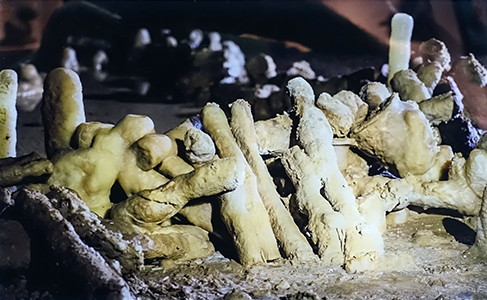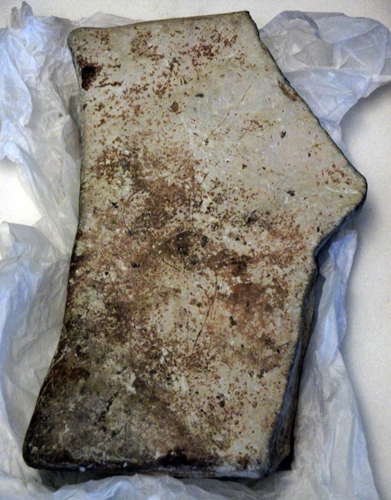Back to Don's Maps
Back to Venus figures from the Stone Age
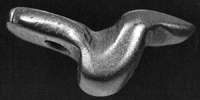 The Venus figures of Neuchâtel - Monruz
The Venus figures of Neuchâtel - Monruz 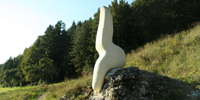 The Venus figures of Petersfels (Engen)
The Venus figures of Petersfels (Engen)
Venus of Courbet
The sites of Courbet, Bruniquel and Montastruc
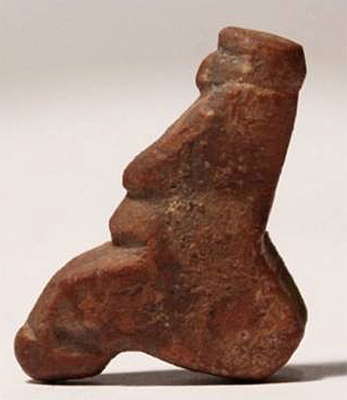
The Courbet venus has been carved so that it is in a seated position, rather than standing erect as most venuses do.
Photo: http://www.connaissancedesarts.com/archeologie/diaporama/les-femmes-de-la-prehistoire-90233.php#

The Courbet venus. About 14 900 years old. Fine-grained red quartzite. 25 mm. Musée Toulouse-Lautrec d’Albi.
Photo: Caldwell (2005)
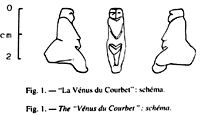
La Vénus du Courbet ~ 14 500 BP.
Photo and text above: Ladier (1992)
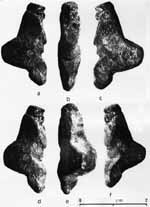 La Vénus du Courbet
La Vénus du Courbet
a profil droit - right side view
b vue de face - front side view
c profil gauche - left side view
d vue de 3/4 droit - right 3/4 side view
e vue de dos - back side view
f vue de 3/4 gauche - left 3/4 side
Photo and text above: Ladier (1992)

The 'Grotte du Courbet' (Penne, Tarn) has been known since the last century for the richness of its portable bone art dating from the Middle and Late Magdalenian.
On 30th July I986, during an urgent salvage dig a 'Venus' was uncovered. It is a very small figurine: 25mm x l8mm x 8mm, carved in red sandstone. It is complete and the face is fairly detailed. The statuette was at the entrance to the cave, in a little cache, corresponding to the cave's earliest occupation ascribed to Middle Magdalenian IV.
Photo and text above: Ladier (1992)
The site
The Roc du Courbet is one of a series of Upper Palaeolithic rockshelters near the village of Bruniquel, in France's Tarn region. Located within the face of a massif or cliff (now known as Courbet), it was first explored by Vicomte de Lastic Saint-Jal in 1863, and then by de Lastic, M. des Serres and R. Owen in 1864 (Owen1869a). It is believed that the majority of the remains recovered were derived from de Lastic's black layer or 'couche noire', which is thought to date to Magdalenian V or VI; however, the provenance of remains within this layer is not clear. Furthermore, both human and animal remains were found within not only a black layer ('limon noir'), but also a red layer ('limon rouge') and a breccia deposit. Owen took such an interest in the cave itself, as well as the faunal and artefactual remains which had been recovered from it, that he purchased de Lastic's first collection for the British Museum in 1864.
Text above: Kaagan et al. (2011)
The Courbet Cave is located on the bench of the Aveyron River, but 20 km from the four Bruniquel shelters, only 1 km south-west from the village of Penne - Tarn, and is near to the Grottes de la Magdeleine-des-Albis.
( my thanks to Barbara Salvans, who supplied the above location information - Don )
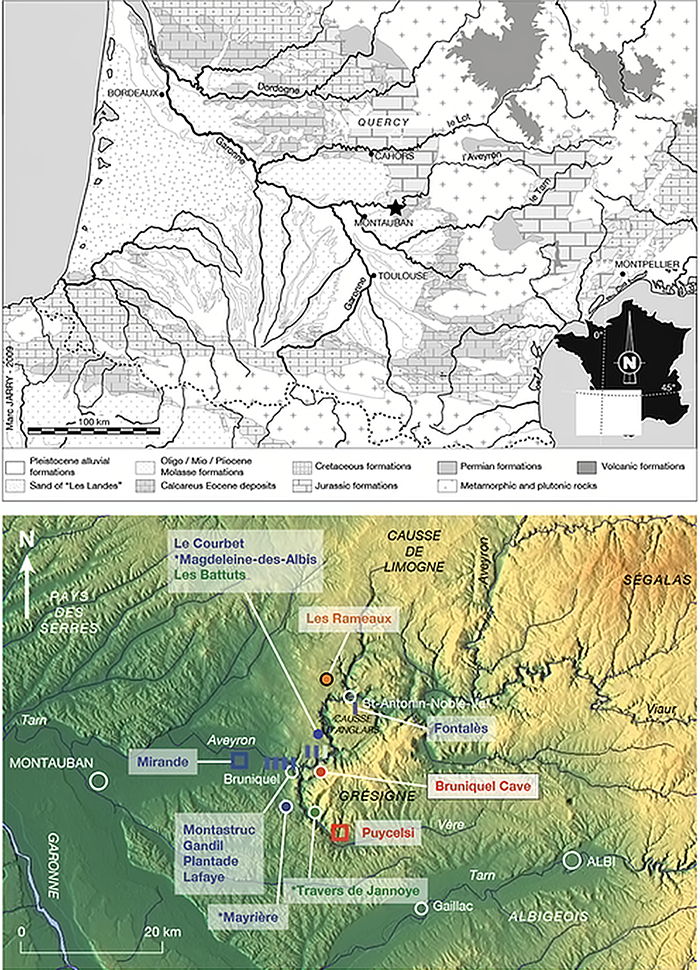
Location of the cave and abri complex.
Note that the lower map shows the approximate locations of Montastruc, Bruniquel Cave, and Le Courbet, all within a few kilometres of each other.
Photo: Jaubert et al. (2016)
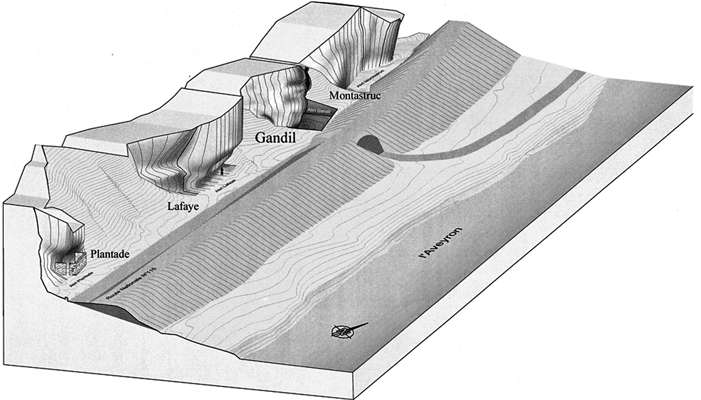
View of the abris known as the Bruniquel rock-shelters, including Montastruc, Gandil, Lafaye and Plantade, beside the river Aveyron.
(DAO : O. Onezime, INRAP, modified).
Photo: Langlais et al. (2007)
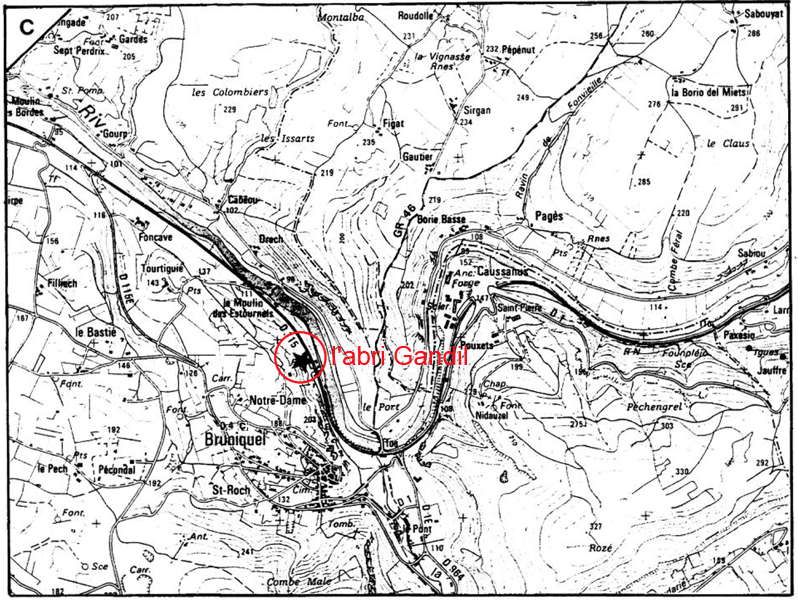
Extract from the topographic map at1/25 000 of Montricoux (n°2141 est) showing local morphology and the location of the Gandil site, shown with a star, and with a red circle. The river is the Aveyron.
The deposits of the Gandil Rockshelter were laid down in fluvial context during the Oldest Dryas episode.
Photo and text: Texier (1997)
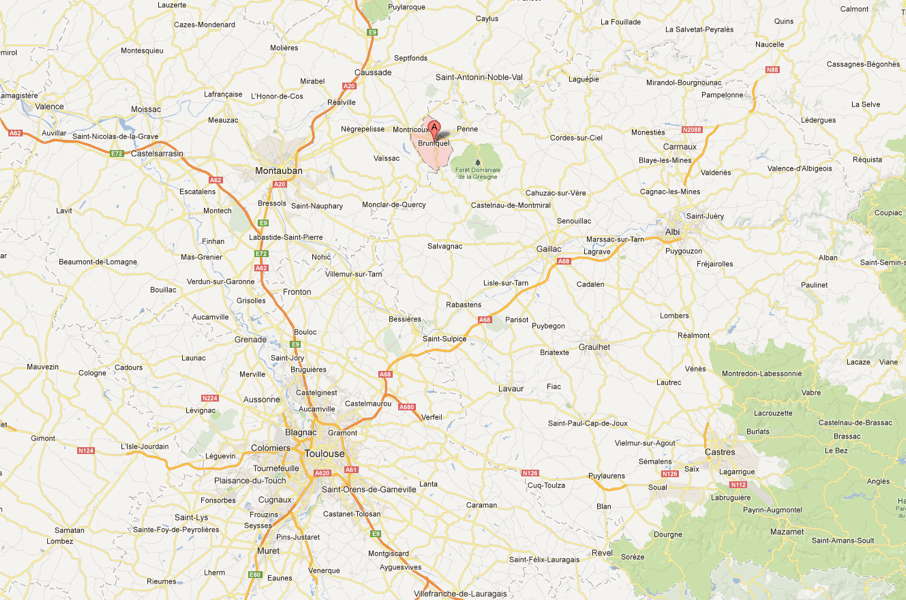
Map of the area. Bruniquel is north of Toulouse.
Photo: Google Maps
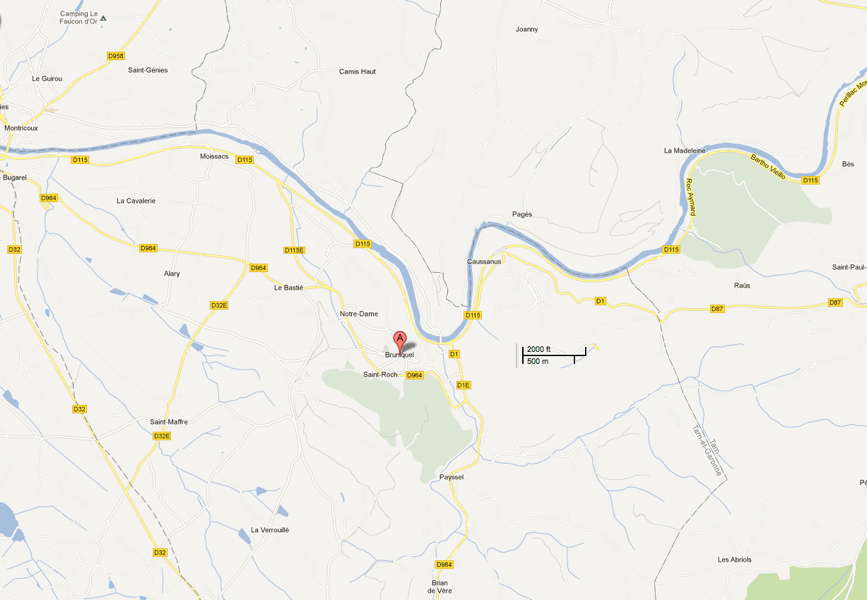
The village of Bruniquel is on the Aveyron River, and there are a series of rock shelters along the river near Bruniquel.
Photo: Google Maps
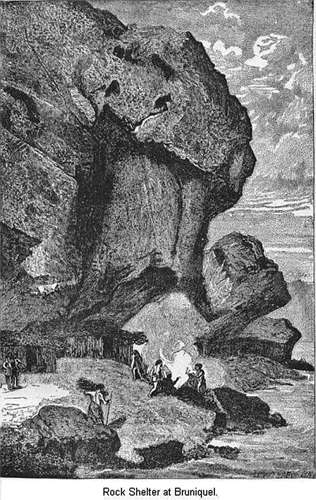
Rock Shelter, Bruniquel. Reindeer Age abode. Antique wood engraved print. Date of printing 1890. From 'Peoples of the world' by Robert Brown, published by Cassel & Co.
Photo: http://www.gutenberg.org/files/2873/2873-h/Chap4.html
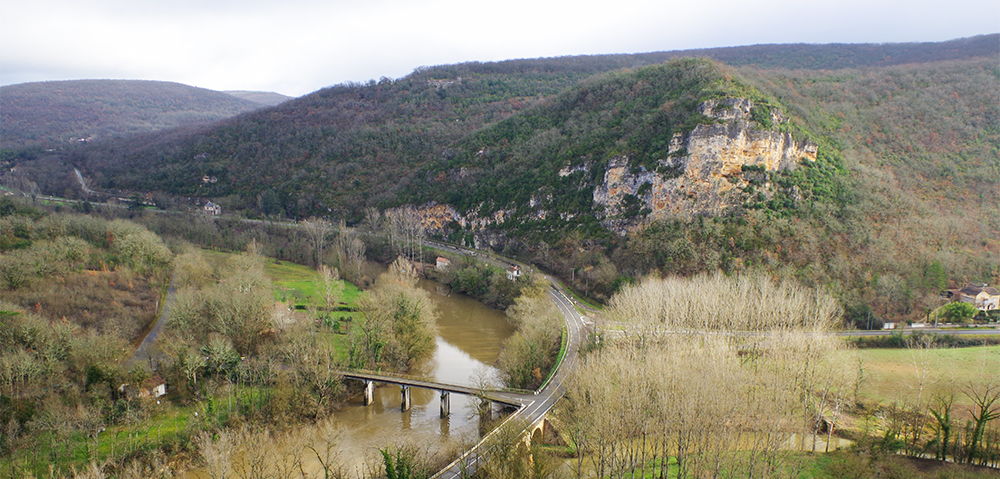
Grotte de Bruniquel, situated in the limestone knoll at the middle right of this image
Photo: © Michel SOULIER – SSAC
Source: http://www.rtl.fr/

Grotte de Bruniquel, interior, showing annular constructions made of broken stalagmites by early Neanderthals.
They date from 176 500 BP, and were found 336 metres from the entrance of the cave.
Photo: © Michel SOULIER – SSAC / Nature Jaubert et al. Source: Jaubert et al. (2016)
The regular geometry of the stalagmite circles, the arrangement of broken stalagmites and several traces of fire demonstrate the anthropogenic origin of these constructions.
Uranium-series dating of stalagmite regrowths on the structures and on burnt bone, combined with the dating of stalagmite tips in the structures, give a reliable and replicated age of 176 500 BP (± 2 100 years), making these edifices among the oldest known well-dated constructions made by humans.
Their presence at 336 metres from the entrance of the cave indicates that humans from this period had already mastered the underground environment, which can be considered a major step in human development.
This discovery indicates that humans began occupying caves much earlier than previously thought. Until now the oldest formally proven cave use dated back only 38 000 years (Chauvet). It also ranks the Bruniquel structures among the very first in human history.
In addition, traces of fire show that the early Neanderthals, well before Homo sapiens, knew how to use fire as a source of light to navigate in safety, and to build structures, in enclosed spaces far from daylight.
Text above adapted from: Jaubert et al. (2016) and the summary of the paper at https://www.sciencedaily.com/releases/2016/06/160601083926.htm
Interior of Bruniquel Cave.
In 1990, the discovery of two circular structures composed of 399 pieces broken from stalagmites on the floor of this cave provoked a veritable earthquake amongst scientists. Situated in a room 336 metres from the entrance, they show that almost 130 000 years before modern humans, Neanderthals had ventured underground. Only traces of several hearths were found, without tools or skeletal remains. The function - practical? symbolic? - of these structures remains unknown to this day.
(left): Salle de la grotte de Bruniquel, low walls, © Yann van den Berghe/SSAC
(right): Salle de la grotte de Bruniquel, hearth, © Michel Soulier/SSAC
Photo: Don Hitchcock 2018
Source and text: Musée de l'Homme, Paris
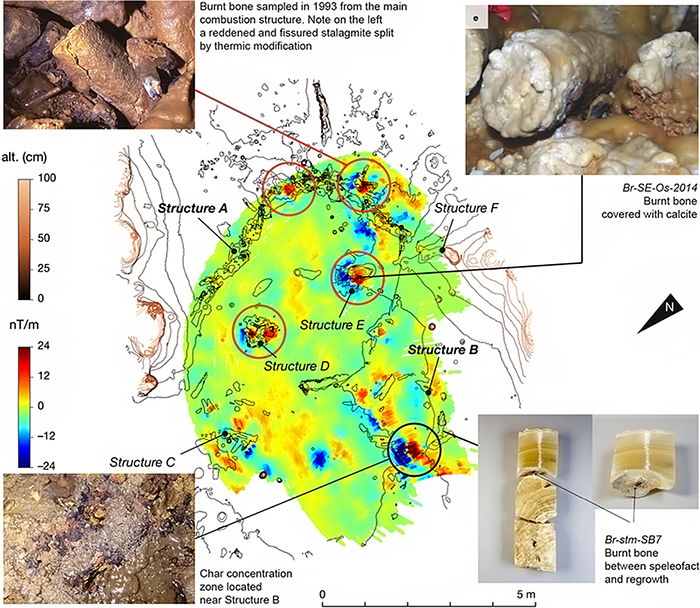
Plan and photos of Neanderthal structures found in Bruniquel Cave.
Photo: Jaubert et al. (2016)

Taking cores for dating from the floor inside one of the structures.
Photo: © Michel SOULIER – SSAC
Source: http://www.rtl.fr/
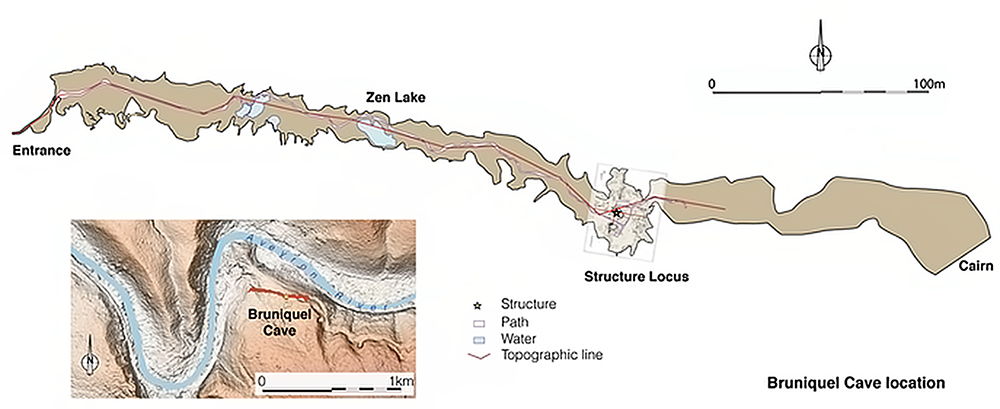
Grotte de Bruniquel, location and cross section, showing the location of the man-made structures.
Photo: Jaubert et al. (2016)
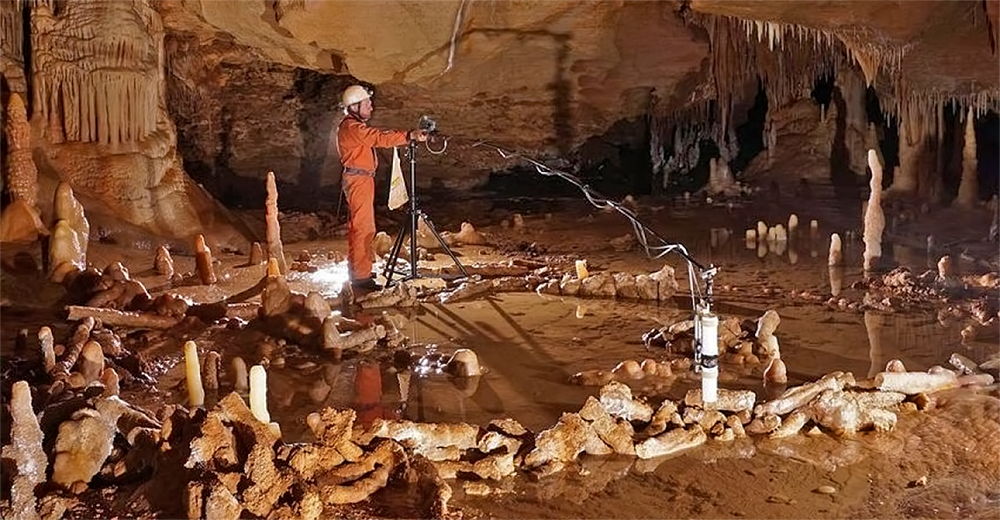
This photo gives a good idea of the scale of the structures.
Photo: Jaubert et al. (2016)
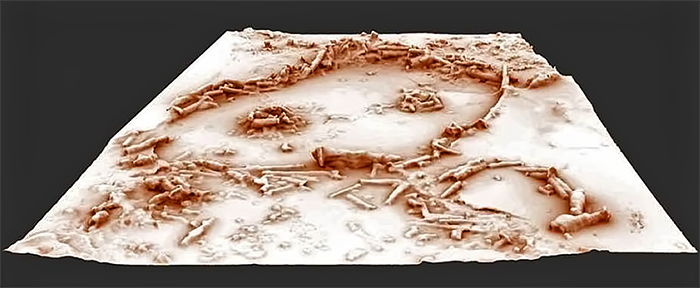
A 3D reconstruction of the Early Neanderthal structures found in Bruniquel Cave by Jaubert's team.
They worked by torchlight, following the same procedure hour after hour: wrench a stalagmite off the cave floor, remove the tip and base, and carefully lay it with the others.
Today we can only guess as to why a group of Neanderthals built a series of large stalagmite structures in a French cave – but the fact they did provides a rare glimpse into our extinct cousin’s potential for social organisation in a challenging environment.
A reassessment of evidence from Bruniquel cave, near Toulouse in south-west France, suggests even more Neanderthal sophistication. In one chamber, 336 metres from the cave entrance, are enigmatic structures – including a ring 7 metres across – built from stalagmites snapped from the cave floor. Natural limestone growths have begun to cover parts of the structure, so by dating these growths a team led by Jacques Jaubert at the University of Bordeaux could work out an approximate age for the stalagmite constructions.
The stalagmite structures are 50 centimetres high in places, says Jaubert. They are built from around 400 individual stalagmites with a combined weight of about 2 tonnes.
'That must take time [to shift],' Jaubert says – although exactly how long it took the Neanderthals to build the structures isn't clear. 'As often in prehistory, measuring time is not easy.' What we do know is that the structures were built in dark, challenging conditions and the builders had no natural light to help them. Indeed, Jaubert’s team found traces of fire at several points around and on the structures.
The simplest explanation is that the structures served as some sort of shelter or refuge – perhaps the stalagmite 'walls' supported a roof of perishable wood, for example – but there are no other artefacts and very few signs of domestic activity in the chamber beyond the presence of one charred bone fragment that possibly belonged to a bear or large herbivore.
That draws comparisons with much later cave sites such as Chauvet, a 30 000 year old site of modern human occupation that is rich in cave art but contained a mere handful of artefacts. So perhaps Bruniquel – like Chauvet – served some ritual role. If so it would provide more evidence for the Neanderthal’s capacity for symbolic thought.
Photo: Xavier Muth - Get in Situ, Archéotransfert, Archéovision -SHS-3D, base photographique Pascal Mora
Source and text: Colin Barras, https://www.newscientist.com/article/2090183-neanderthals-built-mystery-underground-circles-175000-years-ago/
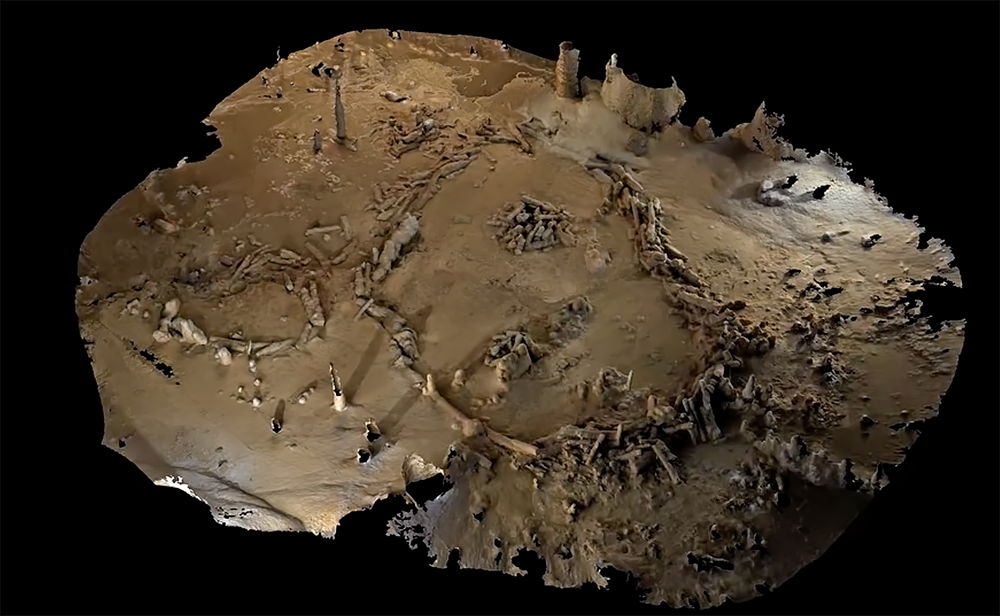
Grotte de Bruniquel 3D model from photogrammetric acquisition by Archéotransfert as part of the study of anthropic structures in Bruniquel Cave.
Photo and text: https://vimeo.com/168174627


Baguette sculptée figurant un cheval bondissant.
Rod carved to represent a leaping horse, from the grotte de Bruniquel, 28 cm.
This is an example of a female propulseur or spear thrower, meaning that there is a socket for the spear between the two hind legs of the carving.
Photo: Don Hitchcock 2014
Source: Facsimile, Musée d'Archeologie Nationale et Domaine, St-Germain-en-Laye

Two horse heads engraved on antler from Roc du Courbet, Bruniquel, BM Palart.508. Length of specimen 15.1cm.
Photo: © The Trustees of the British Museum. All rights reserved.
Kaagan et al. (2011)

The right fourth metatarsal bone of a horse (NHM 38475), 159 mm long, on which an engraving was made, discovered when re-examining material from Courbet collected there by Owen ca 1869.
Photo: © Natural History Museum, London
Text and source: Kaagan et al. (2011)
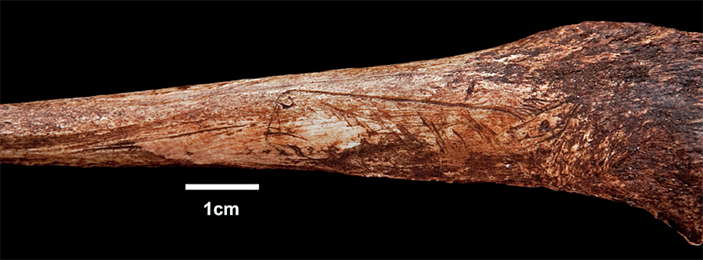
A close-up of the newly discovered horse-head engraving.
The engraving depicts a horse's head in left profile located on the bone's dorsal surface at the proximal end. The image was partly obscured by the specimen identification sticker, confirming that it had not been noticed by previous workers. It is a good example of a 'naturalistic' depiction, in typical Magdalenian style, of a Late Pleistocene wild horse.
Photo: © Natural History Museum, London
Text and source: Kaagan et al. (2011)
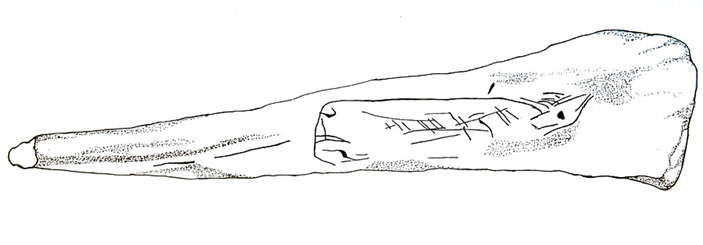
A drawing of the engraving.
Engraved lines above the ear suggest that these animals had a forelock. This is a common trait in domestic horses, but many wild Przewalski's horses also grow a forelock before their mid-summer moult, especially in old age or due to lack of fitness (Mohr, 1971).
Compared to other Palaeolithic depictions of horses, the muzzle in the Courbet engraving is unusually square in shape; other horse-heads from the site seem to share this trait, albeit to a lesser degree.
Photo: © Marion Duffin
Text and source: Kaagan et al. (2011)

Portion of rib of a Deer, with incised outlines of the heads of Reindeer and Bouquetin (ibex - Don ) from the Cavern of Bruniquel.
Photo: Owen (1864)

Portraits of three reindeer and an Ibex, engraved on rib bone; Fragment of decorated rib bone.
Photo: © The Trustees of the British Museum
Text: http://www.telegraph.co.uk/culture/culturepicturegalleries/9847457/Ice-Age-Art-in-pictures.html?frame=2470439
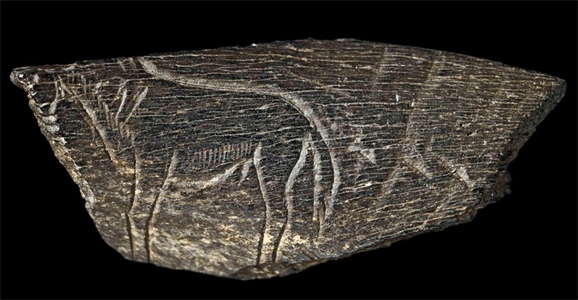
Very small fragment of bone engraved with the figure of a horse facing left, complete except for the head; Palaeolithic; Montastruc, France
Photo: © The Trustees of the British Museum
Text: http://www.telegraph.co.uk/culture/culturepicturegalleries/9847457/Ice-Age-Art-in-pictures.html?frame=2470445

Portion of wing-bone of a bird with incised outlines of the head of Reindeer (Cervus tarandus ) from the Cavern of Bruniquel
Photo: Owen (1864)
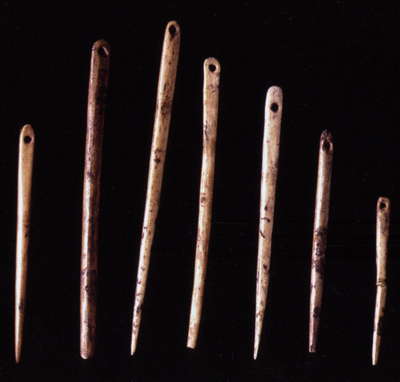
Bone needles from Courbet. Lengths 39 - 55 mm.
Photo: Cook (2013)
Source: British Museum
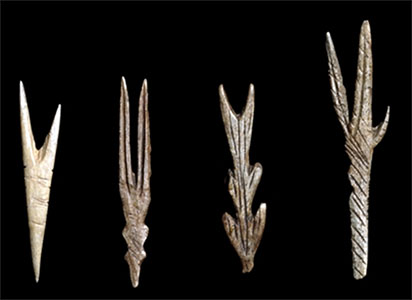
From the cave of Courbet, Penne-Tarn, France.
(These are labelled fishhooks on the British Museum site, but they are typical foëne, used in much the same way as a trident to catch fish. - Don )
From the site:
Late Magdalenian, about 12 500 years old, typical length 49 mm, forked and barbed points
The cave of Courbet is situated by the River Aveyron, and the people who camped there included fish in their diet. As well as fish bones and harpoons, the deposits in the cave also contained little forked and barbed points, of types known from other sites that date to this late phase of the Old Stone Age. Over the years, it has been thought that these points were arrow tips for shooting birds, or spikes for catching small animals in traps. However, it makes most sense that they were hooks used for line fishing.
There are simple V-shaped hooks with two prongs made of bone, as well as small barbed points made of antler. These were tied straight on to the line. The pronged and barbed antler pieces were probably tied to bone or antler shafts to form barbed hooks. The line would probably have been made from animal hair that was twisted or plied into long lengths of suitable thickness and strength. Together with spears and harpoons this equipment reflects the diverse and sophisticated weaponry of late Stone Age hunters.
Photo and text: http://www.britishmuseum.org/explore/highlights/highlight_image.aspx?image=k125490.jpg&retpage=21087
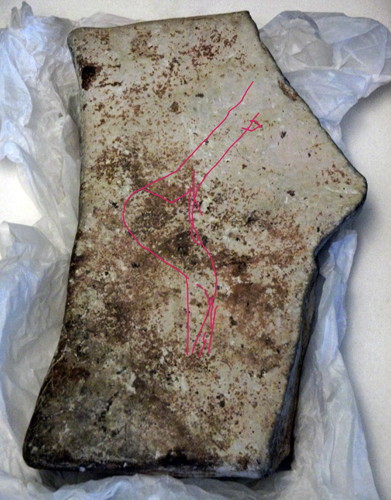
The Montastruc decorated stone (Acc. No. Palart 518) is an example of Ice Age art, now in the British Museum. A human figure that appears to be female has been scratched or engraved to decorate a fragment of a piece of limestone used as a lamp.
The piece was excavated from la grotte du Courbet (commune de Penne, Tarn), Midi-Pyrénées, France, on the northern bank of the River Aveyron, a tributary of the Tarn. It is dated to around 11 000 BC, locally the Late Magdalenian period of the Upper Palaeolithic, towards the end of the last Ice Age.
It was excavated by Edouard Lartet and Henry Christy in 1863, and bequeathed with many other items to the museum by Christy. The dimensions of the stone are: length 230 millimetres, width 145 mm, depth 52 mm. The Swimming Reindeer and Mammoth spear thrower were found at the same site.
The other side of the slab of limestone has a natural depression in which fat was burnt, no doubt for lighting in the rock shelter. The engraving seems to have been made after the stone lamp broke, as the figure is neatly centred on the fragment.
Photo: Johnbod
Permission: Creative Commons Attribution-Share Alike 3.0 Unported license.
Tracing: Don Hitchcock 2013
Text: Wikipedia
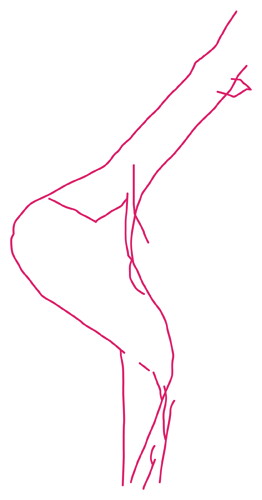
The headless figure is shown from the side, bending to the right, with the large rounded buttocks and thigh carefully drawn. The thin torso features a small sharp triangle that may indicate the breasts, or perhaps arms held out. The two lines defining the front and rear of the profile are continuous and 'confidently drawn', though they converge at knee level. Extra lines below the waist may represent an apron or skirt. Similar characteristics can be found in engraved figures from Neuwied in Germany.
Tracing: Don Hitchcock 2013
Text: Wikipedia
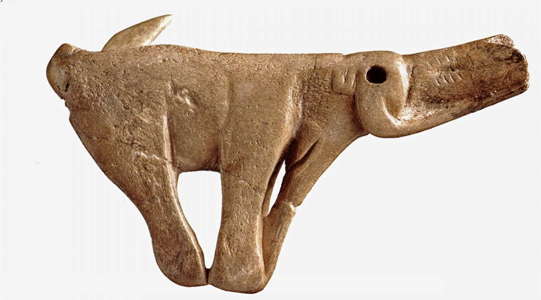
Spear thrower in the shape of a wooly mammoth made from reindeer antler from the rock shelter of Montastruc, Bruniquel, Tarn-et-Garonne, France, Late Magdalenian
This photo appears to have a hook for use as a spear thrower photoshopped in. My understanding is that the original had lost its hook.
Ca 12 500 years old
Length 124 mm
Christy Collection
Photo: © The Trustees of the British Museum
Text: http://www.skydive.ru/en/masterpieces-of-the-british-museum/1732-mammoth-shaped-spear-thrower.html
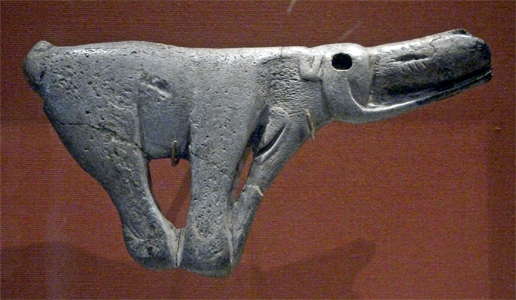
Another version of the spear thrower above. Note that the hook or peg is missing in this photo.
Photo: Johnbod
Permission: Creative Commons Attribution-Share Alike 3.0 Unported license.
This carving in the form of two reindeer is one of the most beautiful pieces of Stone Age art ever found. The reindeer are depicted with their noses up and antlers back, apparently in the act of swimming. This choice of pose might have been suggested by the tapering shape of the mammoth tusk.
The animals are perfectly modelled from all angles. The front figure is a female and has a smaller body and antlers. Her delicately shaded fur is depicted using feathered strokes to represent the reindeers’ distinctive autumn coat. The larger, male, figure is not shaded but the strength of his body is indicated by the bold, sweeping lines of the carving. On both animals the antlers are laid along their backs and their legs are folded underneath them, with the exception of the back left leg of the male which originally extended behind.
From the rockshelter of Montastruc, Bruniquel, Tarn-et-Garonne, France, Late Magdalenian, 12 500 years old
Length 207 mm
Christy Collection
Photo: © The Trustees of the British Museum
Text: http://www.skydive.ru/en/masterpieces-of-the-british-museum/1902-swimming-reindeer-carved-from-the-tip-of-a-mammoth-tusk.html

Swimming reindeer, showing the other side.
Photo: Val
Permission: licensed under the Creative Commons Attribution-Share Alike 2.0 Generic license

Left, cross section of l'abri Monatastruc at the place of the excavations.
Right, stratigraphy at a larger scale.
Photo: Bétirac (1952)
Source: Castel (2008)
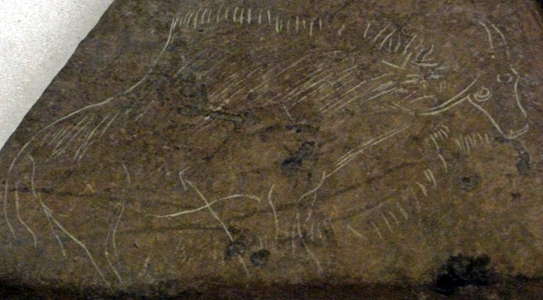
Stone fragment of a waterworn pebble broken on one edge and across the reverse surface. Obverse is engraved with a bison facing right, complete except for the feet which have been omitted. The hump and beard are indicated with lines of hachuring, the back is shaded, a single arrow is drawn on the flank and the head is attached full face to a body in profile. The naivety of head (and figure) is accentuated by two round eyes.
Found at Montastruc.
Image from the British Museum Ice Age Art event, October 2011.
Dimensions: length: 130 mm, width: 75 mm, thickness: 38 mm
Photo: Johnbod
Permission: licensed under the Creative Commons Attribution-Share Alike 3.0 Unported license.
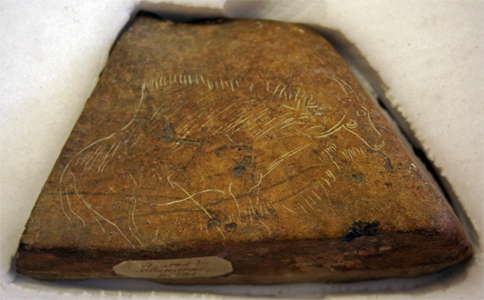

Two more versions of the bison above.
Photo: (left) Discott, (right) Johnbod
Permission: licensed under the Creative Commons Attribution-Share Alike 3.0 Unported license.

This figure is known as the Bruniquel Venus.
Photo: Leroi-Gourhan (1982)
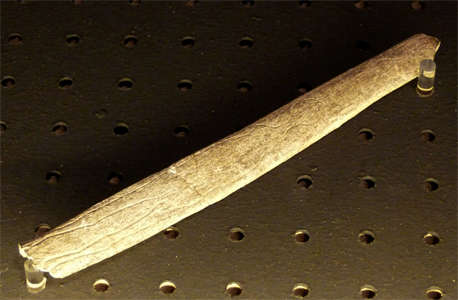
Another version of the Bruniquel Venus.
Photo: http://www.flickr.com/photos/juanalcor/8632123145/sizes/o/in/photostream/
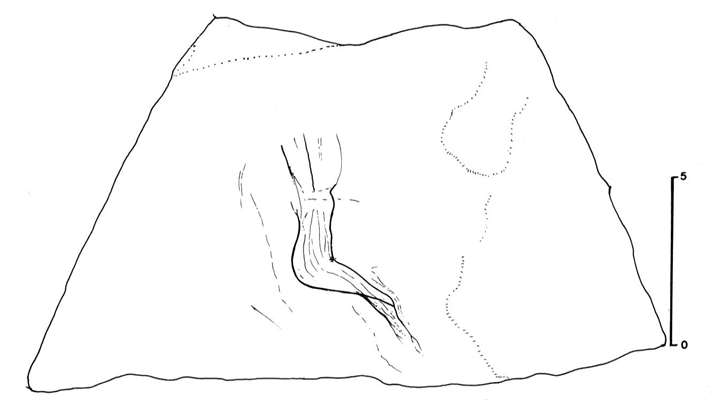
Lalinde figure from la grotte du Courbet, upper Magdalenian, engraved on a tablet.
Photo: Alaux (1972)
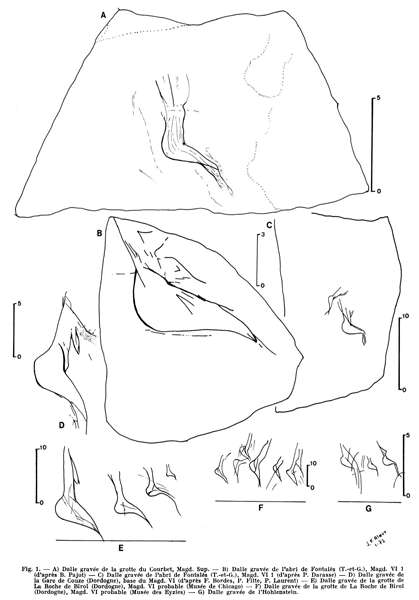
Lalinde figure from la grotte du Courbet, with other Lalinde style figures for comparison.
Photo: Alaux (1972)
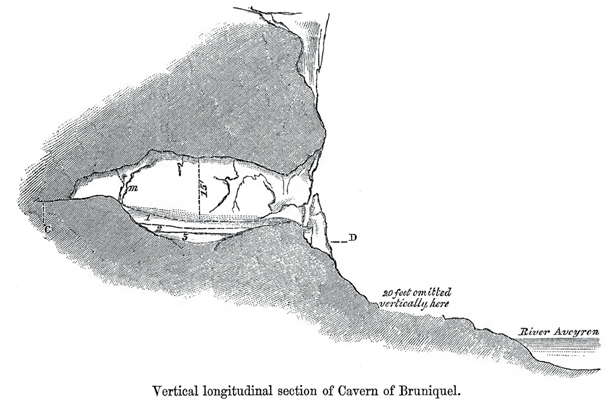
Vertical longitudinal section of Cavern of Bruniquel.
The Cavern of Bruniquel, briefly noticed by Marcel de Serres in the subjoined passage from his work 'Sur les Cavernes a Ossemens', is situated in a grand escarpment of the Jurassic limestone bordering the river Aveyron, opposite the village of Bruniquel, Department of Tarn and Garonne. The entry of the cavern is in the face of the cliff, about 40 feet above the bed of the river, partly concealed by a projecting peak of rock behind which is a platform showing evidence of having been artificially flattened, so as to serve apparently as a stand-point for defence.
Photo and text: Owen (1864)

Entry of Cavern of Bruniquel.
The entry (now bricked up, with a door in charge of a keeper of the proprietor, the Vicomte de Lastic St. Jal) is of an oblong form, about 20 feet in width, and from 8 to 12 feet in height; the cavern widens a little beyond the entry, expanding to a breadth of about 50 feet two-thirds of the way towards the opposite end: the length of the cavern is between 60 and 70 feet; it has a pretty regular domed roof, and from the lowest part of the present excavated floor to the top is from 15 to 20 feet.
Photo and text: Owen (1864)
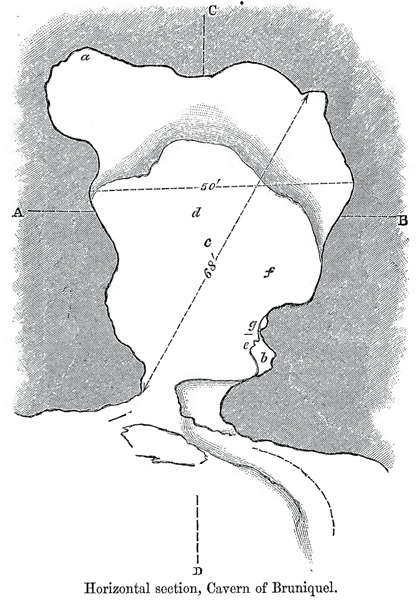
Horizontal section, Cavern of Bruniquel.
Photo: Owen (1864)

Vertical Transverse Section, Cavern of Bruniquel.
Photo: Owen (1864)
References
- Alaux, J., 1972: Gravure féminine sur plaquette calcaire, du Magdalénien supérieur de la grotte du Courbet (commune de Penne, Tarn), Bulletin de la Société préhistorique française1972, tome 69, N. 4. pp. 109-112.
- Bétirac, B., 1952: L'abri Montastruc à Bruniquel (Tarn-et-Garonne), L'Anthropologie56, Paris: p 213-231.
- Caldwell, D., 2005: Common Features and New Ideas concerning Upper Paleolithic Feminine Imagery Arts and Cultures 2010, Barbier-Mueller Museums
- Castel, F., 2008: De la collection privee de Prehistoire Jean Hallemans, au futur musee de Prehistoire de Sciex-sur-leman (Haute-Savoie): Le projet culturelUniversité Pierre Mendes-France, Grenoble II, as part of a Master en Sciences humaines et sociales.
- Cook, J., 2013: Ice Age art: arrival of the modern mind, The British Museum, 18 Feb 2013, ISBN-10: 0714123331, ISBN-13: 978-0714123332
- Jaubert, J. et al., 2016: Early Neanderthal constructions deep in Bruniquel Cave in southwestern France. Nature, 2016; 534 (7605): 111 DOI: 10.1038/nature18291
- Kaagan, L., Bahn P., Lister A., 2011: Discovery of a horse engraving from Bruniquel, France, Antiquity Volume 085 Issue 330 December 2011
- Ladier, E., 1992: Le Venus du Courbet, L'Anthropologie, (Paris) - Tome 96 (1992), n° 2-3, pp. 349-356
- Langlais M., Ladier E., Chalard P., Jarry M., Lacrampe-Cuyaubère F., 2007: Aux origines du Magdalénien 'classique' : les industries de la séquence inférieure de l’Abri Gandil (Bruniquel, Tarn-et-Garonne) Paléo, 19 | 2007 : Spécial table ronde (1ère partie) : Le Gravettien : entités régionales d'une paléoculture européenne, Les Eyzies, juillet 2004, p341-366
- Leroi-Gourhan, A., 1982: Präistorische Kunst, Ursprünge der Kunste in Europa. 5. Aufl. 1982.
- Marshack, A., 1972: The Roots of Civilization: the Cognitive Beginning of Man’s First Art, Symbol and Notation New York, McGraw-Hill
- Mohr, E., 1971: The Asiatic Wild Horse London: J.A. Allen and Co. Ltd.
- Owen, R., 1864: Description of the Cavern of Bruniquel and its Organic Contents. No. 970 of Letter-book. British Museum pp. 517-533 January 24th, 1864.
- Rau, S., Naumann D., Barth M., Mühleis Y., Bleckmann C., 2009: Eiszeit: Kunst und Kultur, Thorbecke, 2009, 396p. ISBN: 978-3-7995-0833-9
- Rouzaud, F., 1997: La paléospéléologie ou: l'approche globale des documents anthropiques et paléontologiques conservés dans le karst profondQuaternaire, Volume 8 - Numéro 2-3 - 1997. pp. 257-265.
- Texier, J., 1997: The dépots du site Magdalénien de Gandil à Bruniquel (Tarn-et-Garonne), Dynamique Sédimentaire, signification Paléoenvironmentale, Lithostratographie et implications ArchéologiquesPaléo, N° 9 - DECEMBRE 1997 - Page 263 à 277
